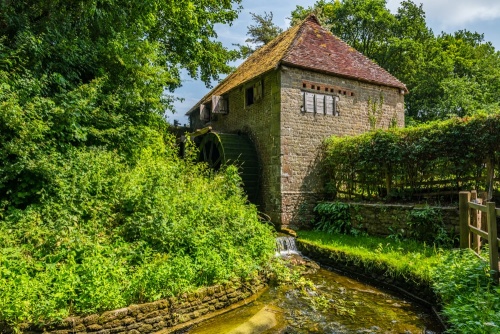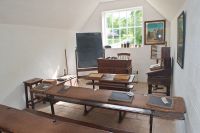
Over 50 historic buildings rescued from demolition have been carefully dismantled and reconstructed in this fascinating rural site north of Chichester. Among the many buildings on display is a medieval farmstead, complete with furniture and livestock, a watermill, and a Tudor market hall. There are numerous hands-on exhibits of building materials and techniques.
The Weald and Downland Living Museum (formerly the Weald and Downland Open-Air Museum) is one of the finest open-air museums in Britain, boasting a wonderful collection of historic buildings that have been saved from destruction.
Museum Highlights
Bayleaf Farmhouse - built in the early 15th century, this is an attractive timber-framed Wealden hall house with a central hall warmed by an open fire. A solar stands at one end and a service area at the other. The farmhouse is shown with replica medieval furniture so that visitors can see it as it would have looked when it was lived in.

Cowfold Barn - a timber-framed barn from Cowfold, Sussex, built around 1536. It was used to store and thresh arable crops, including barley, wheat, rye, and oats. It has been built near Bayleaf Farmhouse to illustrate a typical Wealden farmstead from the late-medieval era, with a stack yard on one side and a cattle yard on the other.

Winkhurst Tudor Kitchen - an early 16th-century building found in Sundridge, Kent. This building once formed part of a house and was used not only for cooking but for brewing and preserving.
Market Square
North Cray Medieval House - an excellent example of a medieval hall house found in North Cray, Kent. The house stretches to four bays with an open hall in the centre flanked by a solar and service area. The timbers are painted red, based on evidence that this was the original 15th-century colouring.

Titchfield Market Hall - this attractive timber-framed hall was built in Titchfield, Hampshire in 1620. It is typical of Tudor and Jacobean market halls, with an open arcade at ground level where goods were traded and a first-floor chamber to serve as a meeting place for the town council. Set into the space under the stairs is a temporary lock-up cage for miscreants.

Horsham Medieval Shop - a 15th-century building with two shops at ground level. One of the shops gives access to a jettied upper chamber. At the back of the shop is an open hall known as a 'smoke bay'.

Crawley Hall - a timber-framed structure built around 1500 in Crawley, Sussex. It has a first-floor hall probably used as a community meeting area.
Lavant Building - an early-17th-century brick building found in lavant, Sussex. It has store rooms on the ground floor and stairs to a meeting hall above. It boasts excellent 17th-century moulded brickwork and mullioned windows.

Pevensey Windpump - a rare surviving example of a wind-powered pump with a hollow central shaft carrying a windshaft and sails.
Beeding Toll House - a small weather-boarded house and garden built in 1807 for a toll-keeper on a turnpike road at Beeding, Sussex. Outside the cottage is a toll board, brought here from Northchapel, giving a breakdown of all the tolls payable by users of the turnpike.

Rural Homes
Tindall's Cottage - this picturesque timber-framed cottage comes from Ticehurst, Sussex, and was built sometime around 1700. Almost all the oak timbers used in its construction were reused from an earlier building. It is similar in style to nearby Poplar Cottage, with a gable-end chimney at one end and a hipped roof at the other gable. The cottage was pulled down in 1974 to make way for the construction of Bewl Water reservoir.

Poplar Cottage - found in Washington, Sussex, this simple building was likely home to a craftsman or landless labourer. It originally stood on the edge of Washington Common. The house boasts one heated room, with the fireplace tucked into a 'smoke bay', an early variety of chimney.

Pendean Farmhouse - found in Midhurst, Sussex, this timber-framed dwelling was built in 1609 with two ground-floor rooms heated by a brick chimney. This shows the transition from the earlier medieval layout with an open hall. The house does, however, retain medieval-style unglazed windows.

Sole Street Medieval House - from the village of Sole Street, Kent, this timber-framed house is built around an open hall with aisles and a later cross wing at the service end of the hall.

Victorian Era
Whittaker's Cottage - a railway worker's cottage and garden from the late Victorian period. The garden features vegetables popular from 1870-1900.

West Wittering School - Built as a cart shed in West Wittering, Sussex in the early 1800s, it was converted into a schoolhouse for six poor children of the parish. The school was owned and operated by the Oliver Whitby Charity, which was also responsible for the Bluecoat School in Chichester.

Crafts and Industry
Petersfield Brick-Drying Shed - built in 1733 in Petersfield. This building was used to store freshly made bricks and tiles before they were fired in a kiln. A brickmaker's bench stands at one end of the structure.

Eastwick Park Dairy - a model dairy found on the Eastwick Park Estate in Surrey. Built in 1807 as two octagonal buildings linked by a covered walkway.

Ockley Hay Barn - built in 1805 in Ockley, Surrey, this timber-framed hay barn was a step up from earlier covered haystacks in fields.
Newick Plumber's Workshop - a late-19th-century building with a plumber's workshop on the ground floor and a glazier's workshop above.
Lurgashall Watermill - a water-powered grain mill producing wholemeal flour and animal feed, moved here from Lurgashall, Sussex. The mill is powered by an overshot waterwheel. The mill dates to the 17th century but was in use until the 1930s. It was moved to the museum in 1977.

Sheffield Park Saw-Pit - a 19th-century shed providing cover for sawyers on the Sheffield Park estate.
Southwater Smithy - a Victorian smithy from Southwater, Sussex. It is typical of vill;age smithies across England during the 19th century.

Watersfield Stable - a timber-framed and weatherboarded stable erected in the late 17th century in Watersfield, Sussex. It has standings for 4-5 horses or oxen. A chaff-cutter is stored in the lower end of the stable.

More Highlights
Littlehampton Granary - built around 1731 with a timber frame infilled with bricks. The granary is raised on sixteen stadle stones; mushroom-shaped stones that help keep out rodents and protect the grain from moisture. This large example of granary has its own loft for extra storage.

Downland Gridshell - one of the most intriguing buildings at the Weald and Downland Museum is also one of the newest. The Gridshell is an extraordinary multi-purpose building used as an assembly space for erecting buildings under cover, a workshop space, and a space to store the extensive museum archives. Tours of the archives are usually available every day. Check with staff at the admission centre.

Our visit:
I'd been aware of the Weald and Downland Museum for years, but it wasn't until my wife made a fuss about visiting it that I made the trek, family in tow. Wow! It truly is a remarkable collection of historic buildings. The reconstructed houses, halls, farms, cottages, shops, sheds, and other buildings are spread out over a very large area, joined by easy paths leading through shady, wooded copses of trees.
What really stands out for me is the excellent signposting, showing at a glance where each building came from, what it was used for, when it was built, when it was disassembled and rebuilt on the museum site, and what the major characteristics of the building style are.
And what a mix of buildings! There's everything here, from a late medieval cottage, complete with traditional garden, to an early 20th-century shop, a rough-and-ready village church, and so many styles of houses.

Some of the larger properties have volunteer stewards on site to answer questions, and there are copious information boards on many of the buildings detailing the known history of the property. This truly is a remarkable resource if you have any interest in historic buildings.
Even our 10-year-old daughter, who I feared might be quickly bored, really enjoyed exploring the different types of buildings. We stayed for 4 hours and could easily have stayed for longer if we'd arrived earlier in the day. The Weald and Downland Museum is a fabulous historic resource - it's like walking through a time capsule! Highly recommended.
About Weald and Downland Living Museum
Address: Singleton,
Chichester,
West Sussex,
England, PO18 0EU
Attraction Type: Museum
Location: 6 miles north of Chichester, on the A260
Website: Weald and Downland Living Museum
Email: office@wealddown.co.uk
Historic Houses Association
Location
map
OS: SU872 127
Photo Credit: David Ross and Britain Express
HERITAGE
 We've 'tagged' this attraction information to help you find related historic attractions and learn more about major time periods mentioned.
We've 'tagged' this attraction information to help you find related historic attractions and learn more about major time periods mentioned.
Historic Time Periods:
Find other attractions tagged with:
15th century (Time Period) - 16th century (Time Period) - 17th century (Time Period) - 19th century (Time Period) - Medieval (Time Period) - Tudor (Time Period) - Victorian (Time Period) - Whitby (Place) -
NEARBY HISTORIC ATTRACTIONS
Heritage Rated from 1- 5 (low to exceptional) on historic interest
West Dean Gardens - 0.6 miles (Garden) ![]()
West Dean, St Andrew's Church - 0.7 miles (Historic Church) ![]()
Goodwood House - 2.6 miles (Historic House) ![]()
Devil's Humps Barrows - 3.4 miles (Prehistoric Site) ![]()
Boxgrove Priory - 3.9 miles (Abbey) ![]()
Tangmere Military Aviation Museum - 4.6 miles (Museum) ![]()
Chichester Castle - 4.7 miles (Castle) ![]()
Chichester Guildhall - 4.8 miles (Historic Church) ![]()
Nearest Holiday Cottages to Weald and Downland Living Museum:
Runcton, West Sussex
Sleeps: 6
Stay from: £573 - 2408
More self catering near Weald and Downland Living Museum















